Magnetic Response Dependence of ZnO Based Thin Films on Ag Doping and Processing Architecture
Abstract
:1. Introduction
2. Materials and Methods
2.1. Films Deposition
2.2. Structural and Magnetic Characterization
3. Results and Discussion
3.1. Structural Properties
3.2. Magnetic Results
4. Conclusions
Author Contributions
Funding
Acknowledgments
Conflicts of Interest
References
- He, M.; Tian, Y.F.; Springer, D.; Putra, I.A.; Xing, G.Z.; Chia, E.E.M.; Cheong, S.A.; Wu, T. Polaronic transport and magnetism in Ag-doped ZnO. Appl. Phys. Lett. 2011, 99, 222511. [Google Scholar] [CrossRef]
- Wolf, S.A. Spintronics: A Spin-Based Electronics Vision for the Future. Science 2001, 294, 1488–1495. [Google Scholar] [CrossRef] [Green Version]
- García, M.A.; Ruiz-González, M.L.; Quesada, A.; Costa-Krämer, J.L.; Fernández, J.F.; Khatib, S.J.; Wennberg, A.; Caballero, A.C.; Martín-González, M.S.; Villegas, M.; et al. Interface double-exchange ferromagnetism in the Mn-Zn-O system: New class of biphase magnetism. Phys. Rev. Lett. 2005, 94, 217206. [Google Scholar]
- Yoon, S.D.; Chen, Y.; Yang, A.; Goodrich, T.L.; Zuo, X.; Arena, D.A.; Ziemer, K.; Vittoria, C.; Harris, V.G. Oxygen-defect-induced magnetism to 880 K in semiconducting anatase TiO2-δ films. J. Phys. Condens. Matter 2006, 18, L355–L361. [Google Scholar] [CrossRef] [Green Version]
- Coey, J.M.D.; Venkatesan, M.; Fitzgerald, C.B. Donor impurity band exchange in dilute ferromagnetic oxides. Nat. Mater. 2005, 4, 173–179. [Google Scholar] [CrossRef]
- Shinde, S.R.; Ogale, S.B.; Higgins, J.S.; Zheng, H.; Millis, A.J.; Kulkarni, V.N.; Ramesh, R.; Greene, R.L.; Venkatesan, T. Co-occurrence of superparamagnetism and anomalous Hall effect in highly reduced Cobalt-doped rutile TiO2 Films. Phys. Rev. Lett. 2004, 92, 166601. [Google Scholar] [CrossRef] [PubMed] [Green Version]
- Herng, T.S.; Qi, D.-C.; Berlijn, T.; Yi, J.B.; Yang, K.S.; Dai, Y.; Feng, Y.P.; Santoso, I.; Sánchez-Hanke, C.; Gao, X.Y.; et al. Room-temperature ferromagnetism of Cu-Doped ZnO films probed by soft X-ray magnetic circular dichroism. Phys. Rev. Lett. 2010, 105, 207201. [Google Scholar] [CrossRef] [PubMed] [Green Version]
- Ali, N.; Singh, B.; Khan, Z.A.; Vijaya, A.R.; Tarafder, K.; Ghosh, S. Origin of ferromagnetism in Cu-doped ZnO. Sci. Rep. 2019, 9, 2461. [Google Scholar]
- Shah, A.H.; Basheer Ahamed, M.; Manikandan, E.; Chandramohan, R.; Iydroose, M. Magnetic, optical and structural studies on Ag doped ZnO nanoparticles. J. Mater. Sci. Mater. Electron. 2013, 24, 2302–2308. [Google Scholar]
- Garcia, M.A.; Merino, J.M.; Fernández Pinel, E.; Quesada, A.; de la Venta, J.; Ruíz González, M.L.; Castro, G.R.; Crespo, P.; Llopis, J.; González-Calbet, J.M.; et al. Magnetic properties of ZnO nanoparticles. Nano Lett. 2007, 7, 1489–1494. [Google Scholar]
- Souza, R.P.A.; Motta, F.V.; Nascimento, J.H.O.; Bomio, M.R.D.; Borges, F.M.M.; Correa, M.A.; Longo, E.; Li, M.S.; Bohn, F.; Paskocimas, C.A. Effect of Ag clusters doping on the photoluminescence, photocatalysis and magnetic properties of ZnO nanorods prepared by facile microwave-assisted hydrothermal synthesis. J. Mater. Sci. Mater. Electron. 2017, 28, 11059–11069. [Google Scholar]
- Ahmed Khan, Z.; Rai, A.; Roy Barman, S.; Ghosh, S. Green luminescence and room temperature ferromagnetism in Cu doped ZnO. Appl. Phys. Lett. 2013, 102, 022105. [Google Scholar]
- Ferreira, A.; Martin, N.; Lanceros-Méndez, S.; Vaz, F. Tuning electrical resistivity anisotropy of ZnO thin films for resistive sensor applications. Thin Solid Films 2018, 654, 93–99. [Google Scholar]
- Ferreira, A.; Pedrosa, P.; Martin, N.; Yazdi, M.A.P.; Billard, A.; Lanceros-Méndez, S.; Vaz, F. Nanostructured Ti1-xCux thin films with tailored electrical and morphological anisotropy. Thin Solid Films 2019, 672, 47–54. [Google Scholar]
- Ferreira, A.; Correia, V.; Mendes, E.; Lopes, C.; Vaz, J.F.V.; Lanceros-Mendez, S. Piezoresistive Polymer-Based Materials for Real-Time Assessment of the Stump/Socket Interface Pressure in Lower Limb Amputees. IEEE Sens. J. 2017, 17, 2182–2190. [Google Scholar]
- Domingues, R.P.; Rodrigues, M.S.; Proença, M.; Costa, D.; Alves, E.; Barradas, N.P.; Oliveira, F.J.; Silva, R.F.; Borges, J.; Vaz, F. Thin films composed of Au nanoparticles embedded in AlN: Influence of metal concentration and thermal annealing on the LSPR band. Vacuum 2018, 157, 414–421. [Google Scholar]
- Ferreira, A.; Borges, J.; Lopes, C.; Rodrigues, M.S.; Lanceros-Mendez, S.; Vaz, F. Relationship between nano-architectured Ti1-xCux thin film and electrical resistivity for resistance temperature detectors. J. Mater. Sci. 2017, 52, 4878–4885. [Google Scholar]
- Aslan, M.; Oral, A.; Menşur, E.; Gül, A.; Başaran, E. Preparation of c-axis-oriented zinc-oxide thin films and the study of their microstructure and optical properties. Sol. Energy Mater. Sol. C 2004, 82, 543–552. [Google Scholar]
- Liu, Y.; Liu, Y.; Shen, D.; Zhong, G.; Fan, X.; Kong, X.; Mu, R.; Henderson, D. Preferred orientation of ZnO nanoparticles formed by post-thermal annealing zinc implanted silica. Solid State Commun. 2002, 121, 531–536. [Google Scholar]
- Francq, R.; Snyders, R.; Cormier, P.-A. Structural and Morphological study of ZnO-Ag thin films synthesized by reactive magnetron co-sputtering. Vacuum 2017, 137, 1–7. [Google Scholar]
- Fan, Z.; Wang, J.; B. Sullivan, M.; Huan, A.; Singh, D.J.; Ong, K.P. Structural instability of epitaxial (001) BiFeO3 thin films under tensile strain. Sci. Rep. 2015, 4, 4631. [Google Scholar]
- Christen, H.M.; Nam, J.H.; Kim, H.S.; Hatt, A.J.; Spaldin, N.A. Stress-induced R-MA-MC-T symmetry changes in BiFeO3 films. Phys. Rev. B 2011, 83, 144107. [Google Scholar]
- Zak, A.K.; Majid, W.A.; Abrishami, M.; Yousefi, R. X-ray analysis of ZnO nanoparticles by williamson–hall and size–strain plot methods. Solid State Sci. 2011, 13, 251–256. [Google Scholar]
- Zhang, J.-M.; Zhang, Y.; Xu, K.-W.; Ji, V. General compliance transformation relation and applications for anisotropic hexagonal metals. Solid State Commun. 2006, 139, 87–91. [Google Scholar]
- Koyano, M.; QuocBao, P.; ThanhBinh, L.t.; HongHa, L.; NgocLong, N.; Katayama, S. Photoluminescence and raman spectra of ZnO thin films by charged liquid cluster beam technique. Phys Status Solidi (A) 2002, 193, 125–131. [Google Scholar]
- Cong, G.; Wei, H.; Zhang, P.; Peng, W.; Wu, J.; Liu, X.; Jiao, C.; Hu, W.; Zhu, Q.; Wang, Z. One-step growth of ZnO from film to vertically well-aligned nanorods and the morphology-dependent raman scattering. App. Phys. Lett. 2005, 87, 231903. [Google Scholar]
- Wang, X.; Li, Q.; Liu, Z.; Zhang, J.; Liu, Z.; Wang, R. Low-temperature growth and properties of ZnO nanowires. App. Phys. Lett. 2004, 84, 4941–4943. [Google Scholar]
- Exarhos, G.J.; Sharma, S.K. Influence of Processing Variables on the Structure and Properties of ZnO Films; Technical Report; Pacific Northwest Lab.: Richland, WA, USA, 1995. [Google Scholar]
- Zhang, Z.; Huang, B.; Yu, Y.; Cui, D. Electrical properties and Raman spectra of undoped and Al-doped ZnO thin films by metalorganic vapor phase epitaxy. Mater. Sci. Eng. B 2001, 86, 109–112. [Google Scholar]
- Zhuo, S.-Y.; Liu, X.-C.; Xiong, Z.; Yang, J.-H.; Shi, E.-W. Ionized Zinc vacancy mediated ferromagnetism in Copper doped ZnO thin films. AIP Adv. 2012, 2, 012184. [Google Scholar]
- Gazzali, P.M.M.; Rajan, S.; Chandrasekaran, G. Low-temperature magnetic properties of vanadium-doped ZnO nanoparticles. J. Supercond. Nov. Magn. 2018, 31, 2817–2828. [Google Scholar]
- Ma, Y.W.; Yi, J.B.; Ding, J.; Van, L.H.; Zhang, H.T.; Ng, C.M. Inducing ferromagnetism in ZnO through doping of nonmagnetic elements. Appl. Phys. Lett. 2008, 93, 042514. [Google Scholar]
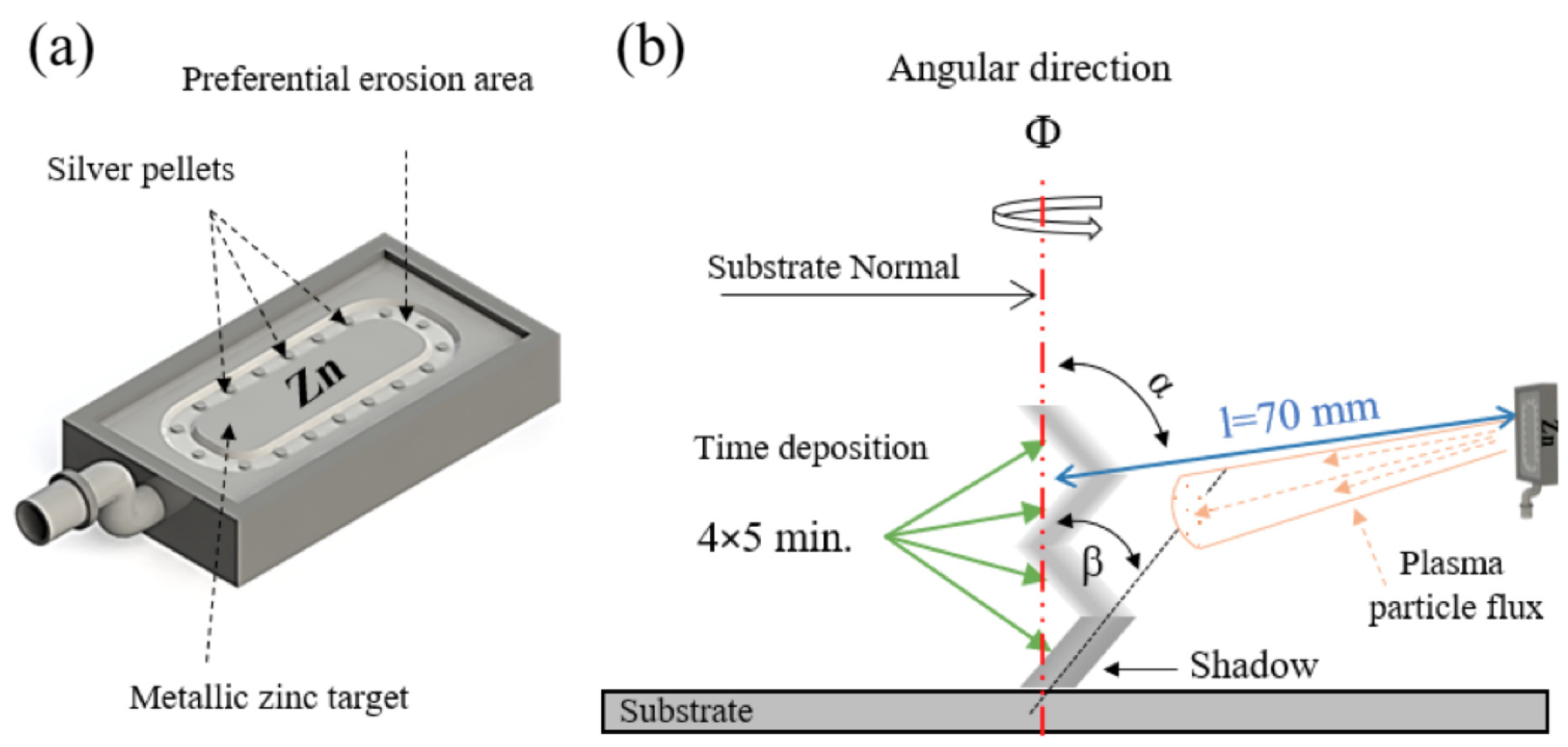
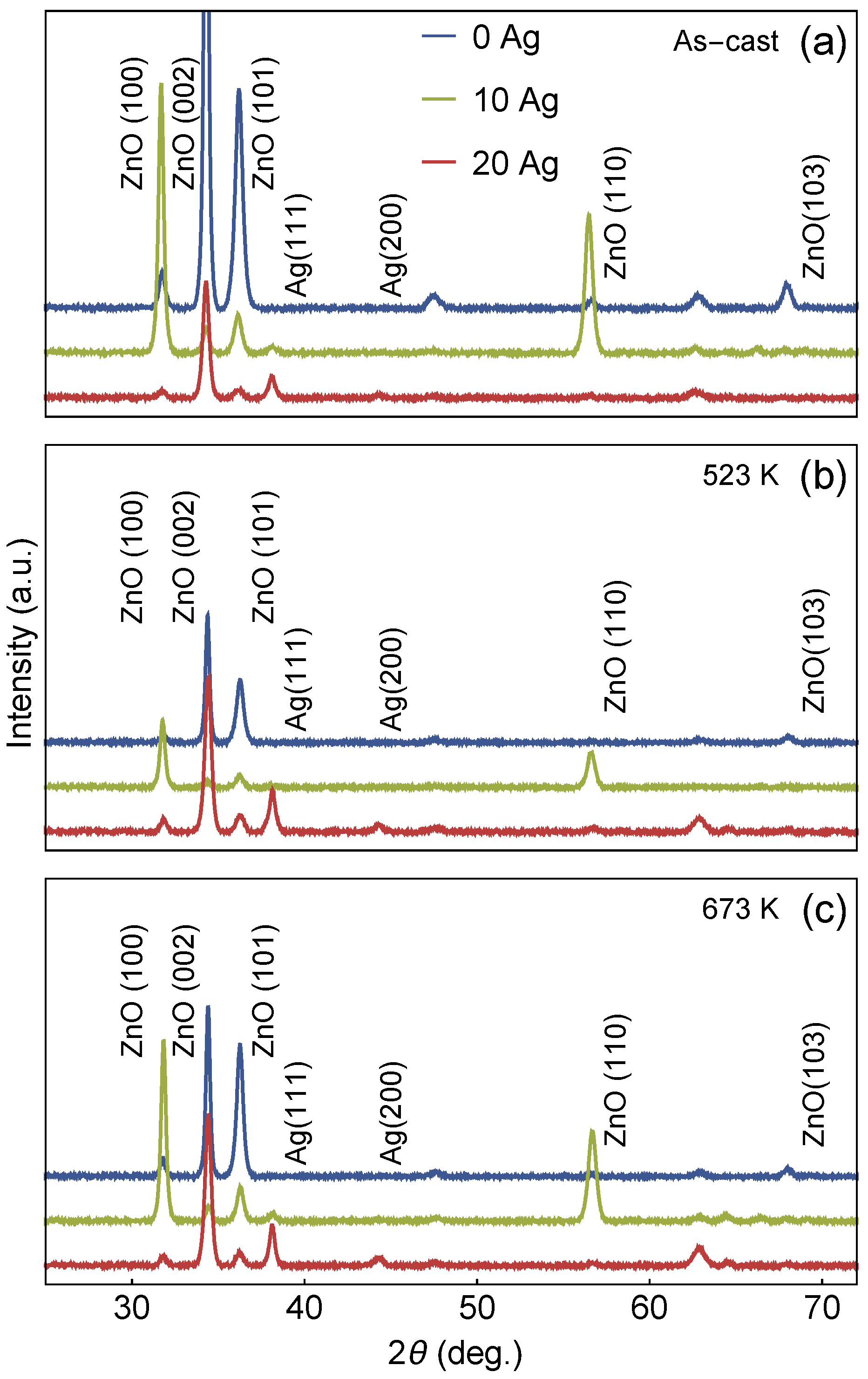

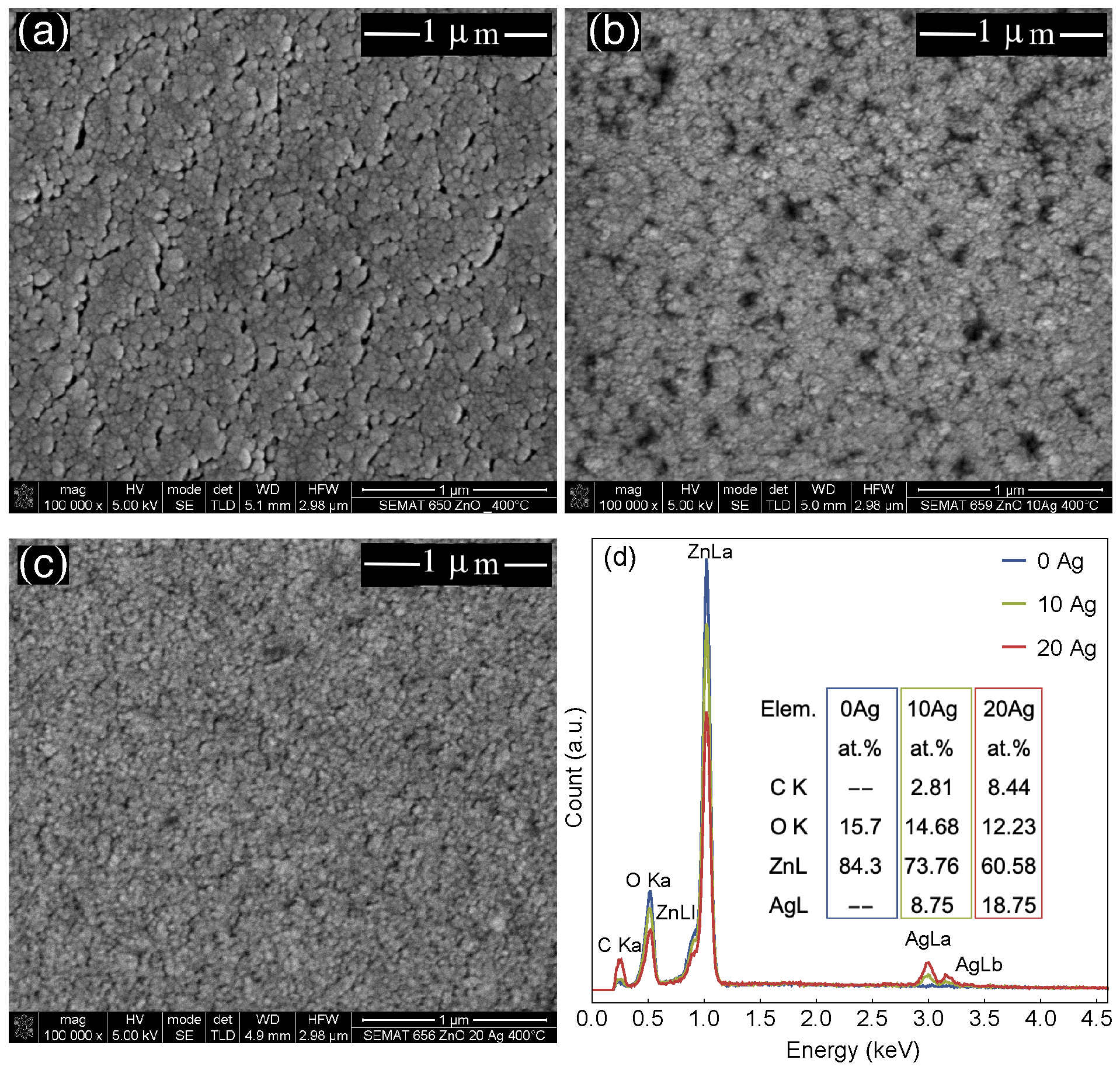


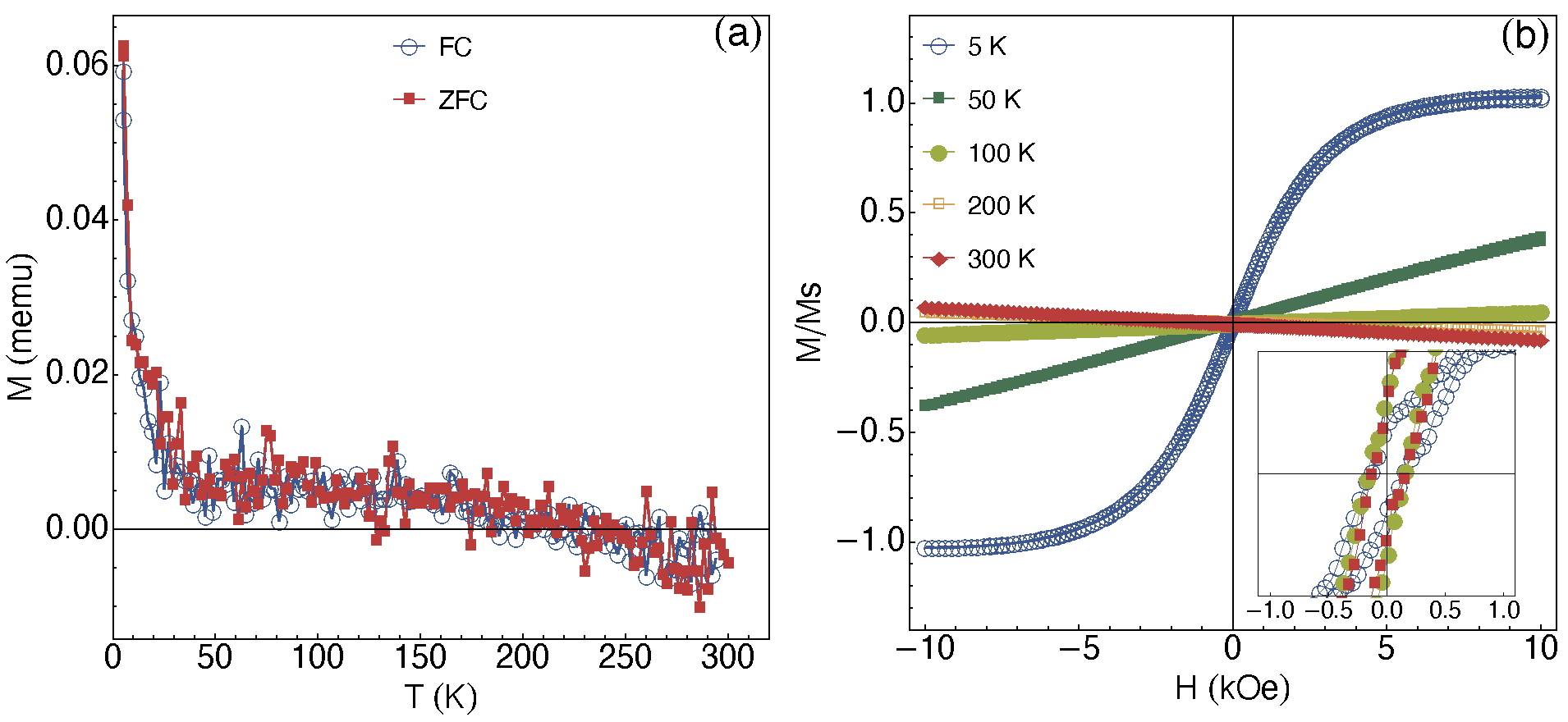
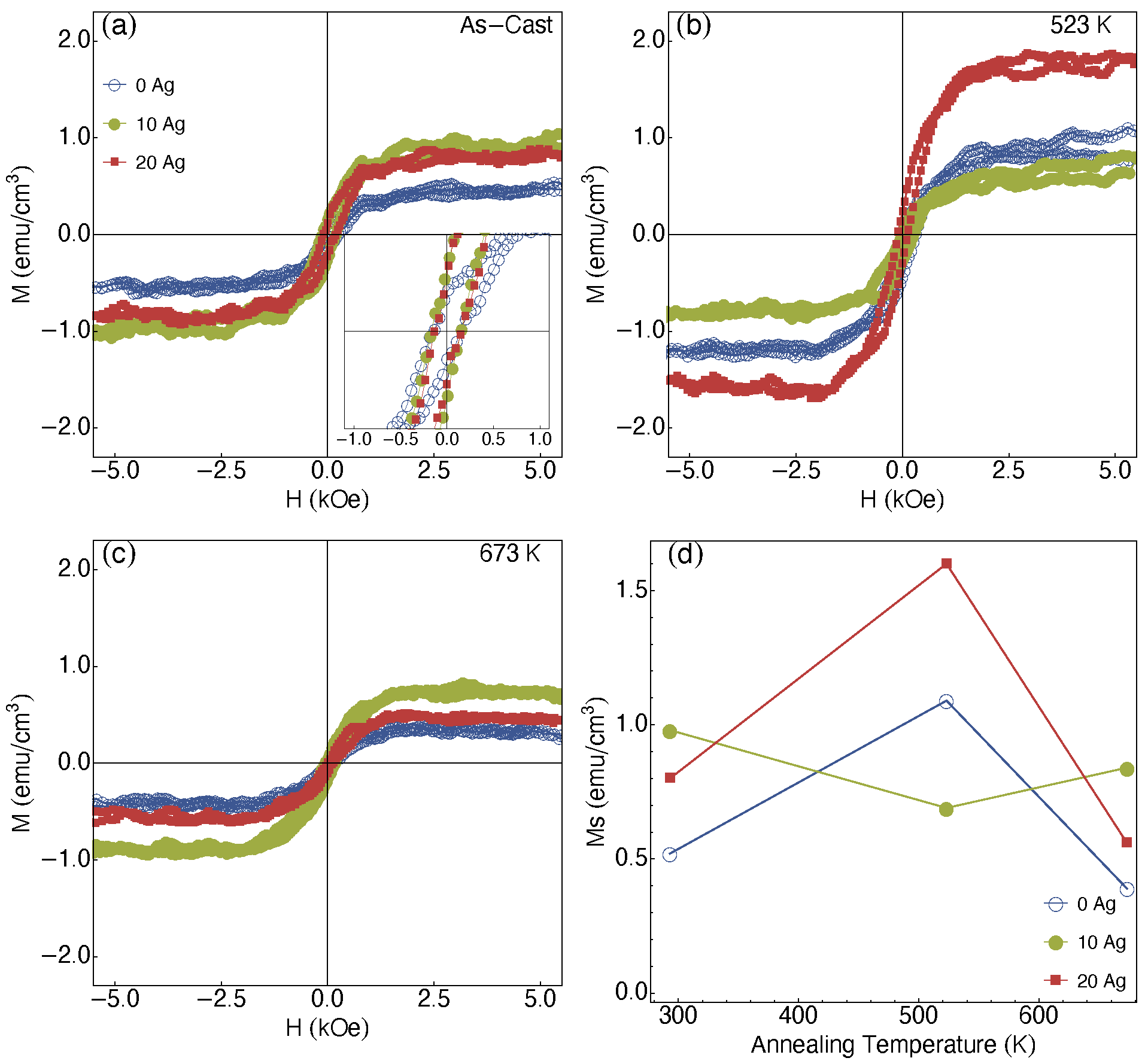
| Annealing | Film | a = b (Å) | c (Å) | Size | Strain |
|---|---|---|---|---|---|
| As-cast | Pure ZnO | 3.2328 | 5.0055 | 29 | 110 |
| 10 at.% Ag-ZnO | 3.2520 | 5.0166 | 33 | 135 | |
| 20 at.% Ag-ZnO | 3.2720 | 5.2425 | 36 | 165 | |
| 523 K | Pure ZnO | 3.2330 | 5.0132 | 32 | 117 |
| 10 at.% Ag-ZnO | 3.2525 | 5.0766 | 37 | 140 | |
| 20 at.% Ag-ZnO | 3.2728 | 5.2555 | 38 | 155 | |
| 673 K | Pure ZnO | 3.2337 | 5.1519 | 37 | 123 |
| 10 at.% Ag-ZnO | 3.2528 | 5.2118 | 40 | 147 | |
| 20 at.% Ag-ZnO | 3.2729 | 5.2627 | 42 | 168 |
© 2020 by the authors. Licensee MDPI, Basel, Switzerland. This article is an open access article distributed under the terms and conditions of the Creative Commons Attribution (CC BY) license (http://creativecommons.org/licenses/by/4.0/).
Share and Cite
G. S. Santos, J.; Correa, M.A.; Ferreira, A.; R. Carvalho, B.; B. da Silva, R.; Bohn, F.; Lanceiros-Méndez, S.; Vaz, F. Magnetic Response Dependence of ZnO Based Thin Films on Ag Doping and Processing Architecture. Materials 2020, 13, 2907. https://doi.org/10.3390/ma13132907
G. S. Santos J, Correa MA, Ferreira A, R. Carvalho B, B. da Silva R, Bohn F, Lanceiros-Méndez S, Vaz F. Magnetic Response Dependence of ZnO Based Thin Films on Ag Doping and Processing Architecture. Materials. 2020; 13(13):2907. https://doi.org/10.3390/ma13132907
Chicago/Turabian StyleG. S. Santos, João, Marcio A. Correa, Armando Ferreira, Bruno R. Carvalho, Rodolfo B. da Silva, Felipe Bohn, Senendxu Lanceiros-Méndez, and Filipe Vaz. 2020. "Magnetic Response Dependence of ZnO Based Thin Films on Ag Doping and Processing Architecture" Materials 13, no. 13: 2907. https://doi.org/10.3390/ma13132907






